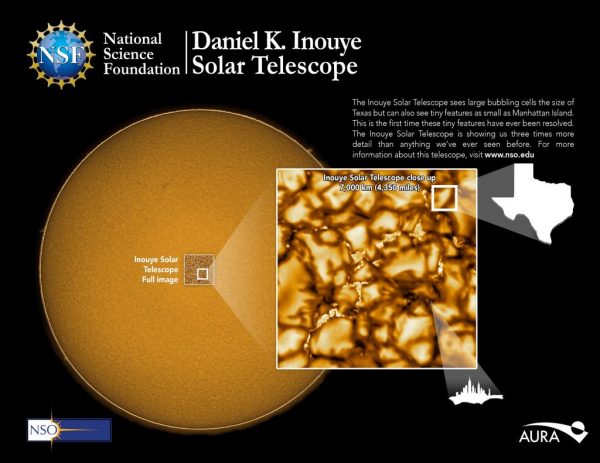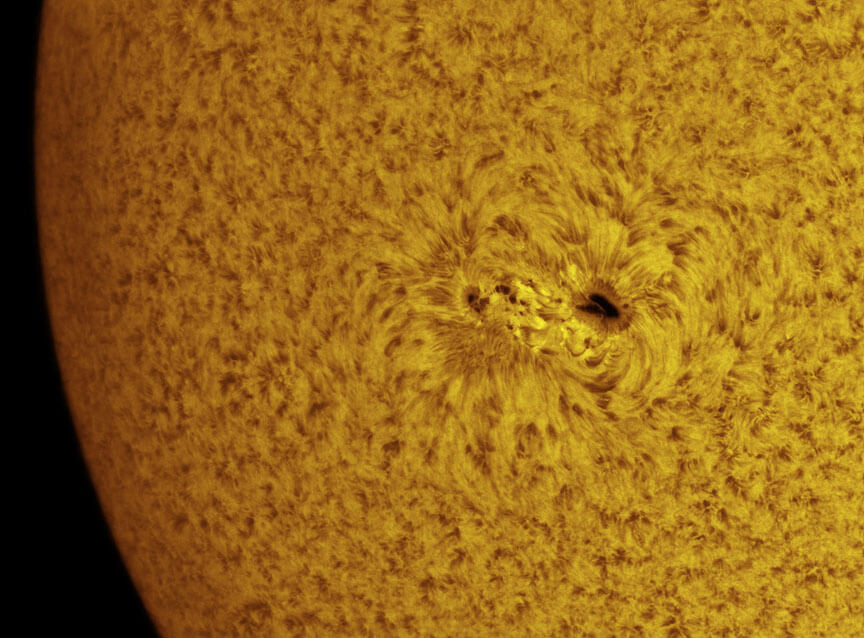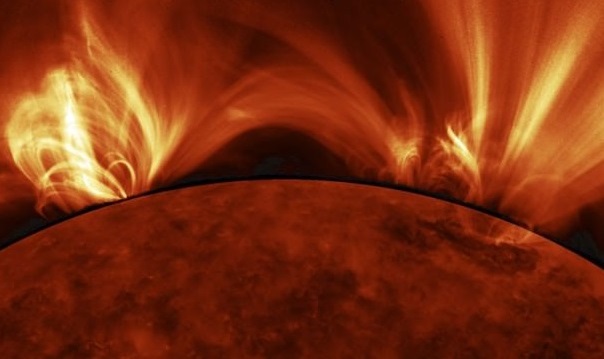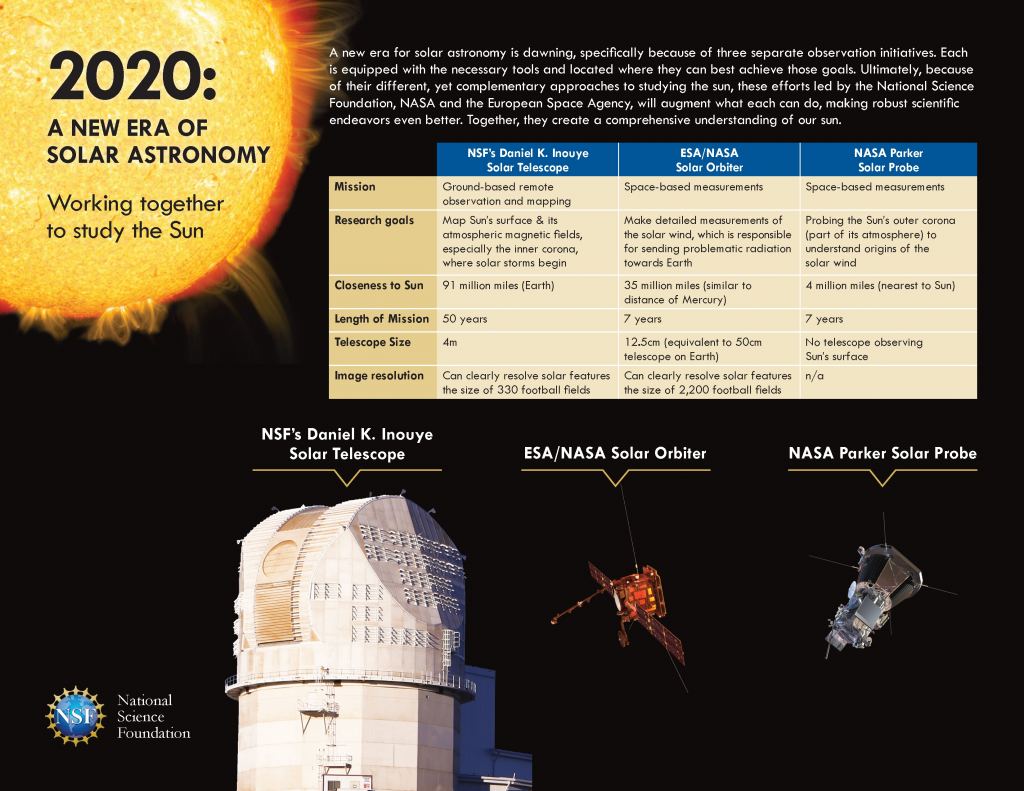This is the Highest Resolution Image Ever Taken of the Surface of the Sun – Universe Today
The Sun’s activity, known as “space weather”, has a significant effect on Earth and the other planets of the Solar System. Periodic eruptions, also known as solar flares, release considerable amounts of electromagnetic radiation, which can interfere with everything from satellites and air travel to electrical grids. For this reason, astrophysicists are trying to get a better look at the Sun so they can predict its weather patterns.
This is the purpose behind the NSF’s 4-meter (13-ft) Daniel K. Inouye Solar Telescope (DKIST) – formerly known as the Advanced Technology Solar Telescope – which is located at the Haleakala Observatory on the island of Maui, Hawaii. Recently, this facility released its first images of the Sun’s surface, which reveal an unprecedented level of detail and offer a preview of what this telescope will reveal in the coming years.
These images provide a close-up view of the Sun’s surface that shows turbulent plasma arranged in a pattern of cell-like structures. These cells are an indication of violent motions that transport hot solar plasma from the interior of the Sun to the surface. This process, known as convection, sees this bright plasma rise to the surface in cells, where it then cools and sinks below the surface in dark lanes.

By obtaining these kinds of precise and clear images of the Sun, astronomers hope to be able to improve their understanding of this process so they can predict sudden changes in space weather. As France Córdova, the NSF director, explained:
“Since NSF began work on this ground-based telescope, we have eagerly awaited the first images. We can now share these images and videos, which are the most detailed of our sun to date. NSF’s Inouye Solar Telescope will be able to map the magnetic fields within the sun’s corona, where solar eruptions occur that can impact life on Earth. This telescope will improve our understanding of what drives space weather and ultimately help forecasters better predict solar storms.”
To put it plainly, the Sun is a G-type (yellow dwarf) main-sequence star that has existed for about 4.6 billion years. This puts it about halfway through its life cycle, which will last for about another 5 billion years. The process of self-sustained nuclear fusion which powers the Sun (and provides all of our light, heat, and energy) consumes about 5 million tons of hydrogen fuel every second.
All of the energy created by this process radiates into space in all directions and reaches to the very edge of the Solar System. Since the 1950s, scientists have understood that Earth resides within the Sun’s atmosphere and that changes in its weather have a profound impact on Earth. Even now, decades later, there is much about the Sun’s most vital processes that remain unknown.

Matt Mountain is the president of the Association of Universities for Research in Astronomy, which manages the Inouye Solar Telescope. As he explained the goal of solar astronomy:
“On Earth, we can predict if it is going to rain pretty much anywhere in the world very accurately, and space weather just isn’t there yet. Our predictions lag behind terrestrial weather by 50 years, if not more. What we need is to grasp the underlying physics behind space weather, and this starts at the sun, which is what the Inouye Solar Telescope will study over the next decades.”
Astronomers have determined that the motion of the Sun’s plasma is related to solar storms because of the way that they cause the Sun’s magnetic field lines to become twisted and tangled. Measuring and characterizing the Sun’s magnetic field is crucial to determining the causes of potentially harmful solar activity – something for which the Inouye Solar Telescope is uniquely qualified.
According to Thomas Rimmele, director of the Inouye Solar Telescope, it all comes down to the Sun’s magnetic field. “To unravel the sun’s biggest mysteries, we have to not only be able to clearly see these tiny structures from 93 million miles away but very precisely measure their magnetic field strength and direction near the surface and trace the field as it extends out into the million-degree corona, the outer atmosphere of the sun.”

One of the biggest benefits to come from a better understanding of solar dynamics is the ability to predict major weather events. At present, governments and space agencies are able to anticipate events about 48 minutes ahead of time. But thanks to the research being conducted by the Inouye Solar Telescope and other solar observatories, astronomers expect to get this up to 48 hours.
This would give us more time to ensure that these events don’t knock out power grids, critical infrastructure, satellites, and space stations. Naturally, the business of monitoring the Sun is no easy task and comes with its fair share of hazards. For this reason, the Inouye Solar Telescope leverages many recent developments in terms of construction, engineering, and astronomy.
This includes its 4 m (13 ft) mirror (the largest of any solar telescope), adaptive optics to compensate for the distortion caused by Earth’s atmosphere, and the pristine viewing conditions atop Haleakala’s over 3000 m (10,000 ft) summit. The telescope also relies on several safeguards to ensure that it does not become overheated from focusing 13 kilowatts of solar power from the Sun.
This is done via a high-tech, liquid-cooled metal torus (the “heat-stop”) that keeps most of the sunlight away from the main mirror and cooling plates that cover the dome and keep temperatures stable around the telescope. The interior of the observatory is also kept cool using 11.25 km (7 mi) of coolant pipes, which are partially chilled by ice that accumulates during the night, and interior shutters that provide air circulation and shade.

“With the largest aperture of any solar telescope, its unique design, and state-of-the-art instrumentation, the Inouye Solar Telescope – for the first time – will be able to perform the most challenging measurements of the sun,” said Rimmele. “After more than 20 years of work by a large team devoted to designing and building a premier solar research observatory, we are close to the finish line. I’m extremely excited to be positioned to observe the first sunspots of the new solar cycle just now ramping up with this incredible telescope.”
David Boboltz, a program director in NSF’s Division of Astronomical Sciences, is also responsible for overseeing the facility’s construction and operations. As he indicated, these images are just the tip of the iceberg for the Inouye Solar Telescope:
“Over the next six months, the Inouye telescope’s team of scientists, engineers and technicians will continue testing and commissioning the telescope to make it ready for use by the international solar scientific community. The Inouye Solar Telescope will collect more information about our sun during the first 5 years of its lifetime than all the solar data gathered since Galileo first pointed a telescope at the sun in 1612.”
The Inouye Solar Telescope is part of a trio of instruments that are poised to revolutionize solar astronomy in the coming years. It is joined by NASA’s Parker Solar Probe (which is currently orbiting the Sun) and the ESA/NASA Solar Orbiter (which is soon to be launched). As Valentin Pillet summarized (the director of the NSF’s National Solar Observatory), it’s an exciting time to be a solar physicist:
“The Inouye Solar Telescope will provide remote sensing of the outer layers of the sun and the magnetic processes that occur in them. These processes propagate into the solar system where the Parker Solar Probe and Solar Orbiter missions will measure their consequences. Altogether, they constitute a genuinely multi-messenger undertaking to understand how stars and their planets are magnetically connected.”
Further Reading: NSF






